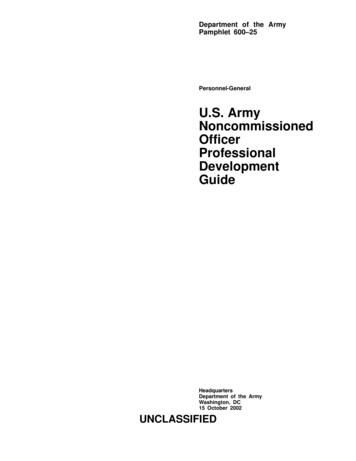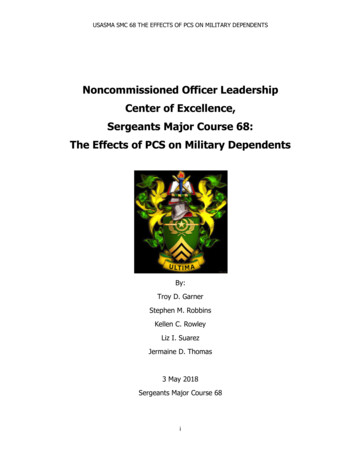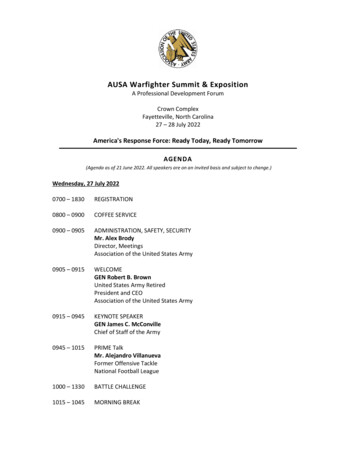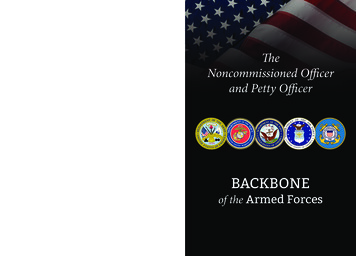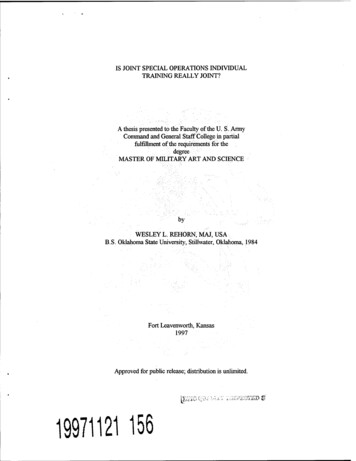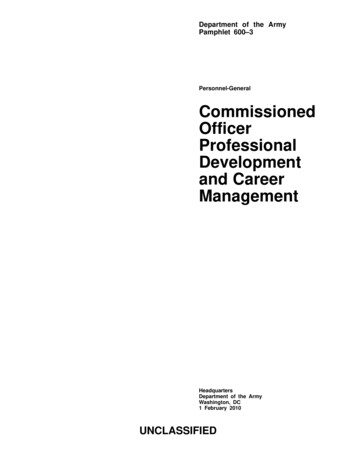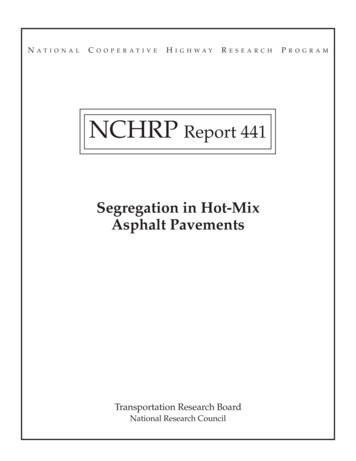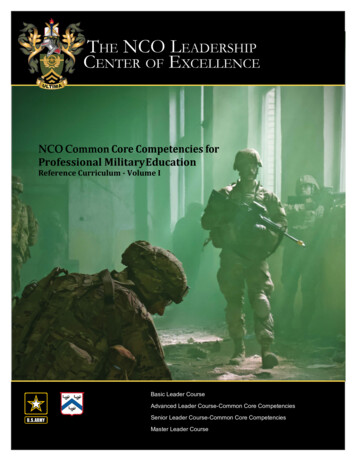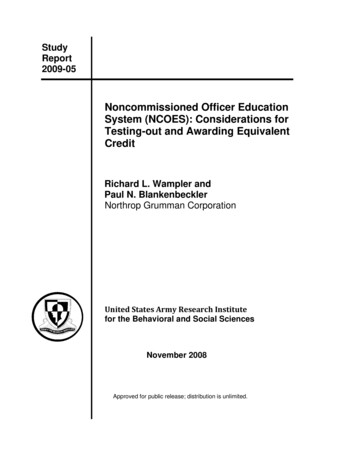
Transcription
StudyReport2009-05Noncommissioned Officer EducationSystem (NCOES): Considerations forTesting-out and Awarding EquivalentCreditRichard L. Wampler andPaul N. BlankenbecklerNorthrop Grumman CorporationUnited States Army Research Institutefor the Behavioral and Social SciencesNovember 2008Approved for public release; distribution is unlimited.
U.S. Army Research Institutefor the Behavioral and Social SciencesA Directorate of the Department of the ArmyDeputy Chief of Staff, G1Authorized and approved for distribution:BARBARA A. BLACK, Ph.D.Research Program ManagerTraining and Leader DevelopmentDivisionMICHELLE SAMS, Ph.D.DirectorTechnical review byKenneth L. Evans, U.S. Army Research InstituteKathleen A. Quinkert, U.S. Army Research InstituteNOTICESDISTRIBUTION: Primary distribution of this Study Report has been made by ARI.Please address correspondence concerning distribution of reports to: U.S. ArmyResearch Institute for the Behavioral and Social Sciences, Attn: DAPE-ARI-ZXM,2511 Jefferson Davis Highway, Arlington, Virginia 22202-3926FINAL DISPOSITION: This Study Report may be destroyed when it is no longerneeded. Please do not return it to the U.S. Army Research Institute for the Behavioraland Social Sciences.NOTE: The findings in this Study Report are not to be construed as an officialDepartment of the Army position, unless so designated by other authorized documents.
REPORT DOCUMENTATION PAGE1. REPORT DATE (dd-mm-yy)2. REPORT TYPENovember 20083. DATES COVERED (from. . . to)FinalMarch - September 20084. TITLE AND SUBTITLE5a. CONTRACT OR GRANT NUMBERW74V8H-04-D-0045 (DO 0027)Noncommissioned Officer Education System (NCOES):Considerations for Testing-out and Awarding Equivalent Credit5b. PROGRAM ELEMENT NUMBER6658036. AUTHOR(S)5c. PROJECT NUMBERRichard L. Wampler and Paul N. Blankenbeckler (Northrop GrummanCorporation)D7305d. TASK NUMBER3825e. WORK UNIT NUMBER8. PERFORMING ORGANIZATION REPORTNUMBER7. PERFORMING ORGANIZATION NAME(S) AND ADDRESS(ES)Northrop Grumman Corporation3565 Macon RoadColumbus, GA 31907US Army Research Institute for theBehavioral and Social SciencesARI-Ft Benning Research UnitP. O. Box 52086Fort Benning, GA 31995-20869. SPONSORING/MONITORING AGENCY NAME(S) AND ADDRESS(ES)U. S. Army Research Institute for the Behavioral & Social SciencesATTN: DAPE-ARI-IJ2511 Jefferson Davis HighwayArlington, VA 22202-392610. MONITOR ACRONYMARI11. MONITOR REPORT NUMBERStudy Report 2009-0512. DISTRIBUTION/AVAILABILITY STATEMENTApproved for public release; distribution is unlimited.13. SUPPLEMENTARY NOTESSubject matter POC and Contracting Officer’s Representative (COR): Dr. Kenneth L. Evans14. ABSTRACT (Maximum 200 words): This research examined the viability of allowing noncommissionedofficers (NCOs) to receive NCO Education System (NCOES) credit based on experience or testing-out. Surveys andinterviews were completed with 164 participants, varying in rank from Lieutenant Colonel to Staff Sergeant.Participants were serving in duty positions ranging from U.S. Army Training and Doctrine Command School Leadersand staff to actual NCO and Officer course instructors, at six Army installations representing 11 Schools. The majority(58%) agreed that testing-out of selected NCOES content is a viable option and 61% agreed that no credit should beawarded solely for experience. An overwhelming majority (90%) agreed that all NCOs should attend some residentNCOES classes to foster interpersonal relationships, 86% agreed that testing-out should include both hands-on andwritten components, and 85% agreed that all NCOs, active and reserve, should be handled the same concerning testingout or receiving equivalent credit. Perspectives differed by rank group and duty position. Participants identifiednumerous educational, administrative, logistical, and sociological items that could be negatively impacted by testingout. They also suggested some testing-out procedures that might mitigate potential impacts.15. SUBJECT TERMSNCO Education SystemNCOESBNCOCSECURITY CLASSIFICATION OF16. REPORTUnclassified17. ABSTRACT18. THIS PAGEUnclassifiedUnclassifiedANCOCEquivalent Credit19. LIMITATION OFABSTRACTUnlimitediTesting20. NUMBEROF PAGES5521. RESPONSIBLE PERSONDiane HadjiosifTechnical PublicationSpecialist703-602-8047
ii
Study Report 2009-05Noncommissioned Officer Education System (NCOES):Considerations for Testing-out and Awarding EquivalentCreditRichard L. Wampler and Paul N. BlankenbecklerNorthrop Grumman CorporationARI – Ft Benning Research UnitScott E. Graham, ChiefU.S. Army Research Institute for the Behavioral and Social Sciences2511 Jefferson Davis Highway, Arlington, Virginia 22202-3926November 2008Army Project Number665803D730Personnel and TrainingAnalysis ActivitiesApproved for public release; distribution is unlimited.iii
ACKNOWLEDGEMENTThe authors wish to express their appreciation to the noncommissioned andcommissioned officers at the six Army installations who provided their time and insightssupporting this research project. Each offered well-reasoned recommendations based on firsthand knowledge and experience with the Army Noncommissioned Officer Education System(NCOES), as well as their insights from combat deployments. The results contained in thisreport would not have been possible without their participation. In addition, we express ourthanks to Mr. Jonathan Rhodes and Mr. Dan Hubbard at U.S. Army Training and DoctrineCommand Headquarters for clearly identifying the key questions to be addressed in this project.iv
NONCOMMISSIONED OFFICER EDUCATION SYSTEM (NCOES): CONSIDERATIONSFOR TESTING-OUT AND AWARDING EQUIVALENT CREDITEXECUTIVE SUMMARYResearch Requirement:World events since September 2001 have exacerbated the ability of manyNoncommissioned Officers (NCOs) to attend institutional NCO Education System (NCOES)courses at the most appropriate points in their professional military careers. Additionally, theArmy has raised its expectations of the NCO Corps, increasing its overall role and scope ofresponsibility. As a result, a growing number of NCOs are assuming duty positions for whichthey have not been formally trained. In response to these developments, the U.S. Army Trainingand Doctrine Command (TRADOC) is developing a new NCO Development Strategy that willmeet force generation time windows and will establish a train-ahead approach to providingNCOs with the skills they need before their duty positions call for them to be used. One possiblecomponent of this strategy is to award NCOES credit to NCOs based on experience or testing.Procedure:Surveys were completed and interviews were conducted with 164 participants across sixArmy installations between May and July 2008. Participants represented 11 TRADOC Schools.They ranged in rank from Lieutenant Colonel to Staff Sergeant and held duty positions varyingfrom TRADOC School and NCO Academy (NCOA) leadership and staff to small groupinstructors for both NCO and Officer courses. Surveys and interviews solicited opinions onwhether some form of equivalent credit or testing-out program should be implemented in lieu ofresident NCOES. If a program was to be implemented, what were the major areas that could beimpacted and what procedures could be used to administer testing-out.Findings:Participants expressed strong agreement on certain aspects of testing-out and awardingNCOES course credit. The majority (58%) agreed that testing-out of selected NCOES content isa viable option, but each School Proponent must revise NCOES course content to make allmaterial relevant and challenging before determining which classes should be allowed fortesting-out. A majority (61%) agreed that no credit should be awarded solely for experience. Anoverwhelming majority (90%) agreed that all NCOs should attend some resident NCOES classesto foster interpersonal relationships. If testing-out is implemented, 86% agreed that testing-outshould include both hands-on and written components. An overwhelming majority (85%) agreedthat all NCOs, active and reserve, should be handled the same concerning testing-out orreceiving equivalent credit. While there was general agreement for most items, perspectivesdiffered by rank group and duty position. Participants identified numerous educational,administrative, logistical, and sociological items that could be negatively impacted by testingout. They also suggested some testing-out procedures that might mitigate potential impacts.v
Utilization and Dissemination of Findings:The findings and suggestions offered by participants should help guide TRADOC effortsto develop a new NCO Development Strategy. Any program that involves testing-out orawarding equivalent credit for NCOES course content can benefit from addressing the potentialimpacts identified in this report and considering the testing recommendations provided byparticipants. The results of this research were briefed to TRADOC G-3/5/7 representatives onSeptember 23, 2008.vi
NONCOMMISSIONED OFFICER EDUCATION SYSTEM (NCOES): CONSIDERATIONSFOR TESTING-OUT AND AWARDING EQUIVALENT CREDITCONTENTSPageINTRODUCTION .1Purpose and Scope .2Related Research Concerning NCO Testing and Promotion.3METHOD .4Participating Installations.4Survey Instrument.5Participants.6RESULTS .8Testing-out of Selected NCOES Content .9Implications of Testing-out.18Best Practices for Administering Testing-out.25DISCUSSION .27SUMMARY.30REFERENCES .33ACRONYMS.35APPENDIX A. SURVEY FORM . A-1APPENDIX B. MEMORANDUM FOR RECORD .B-1LIST OF TABLESTABLE 1. Centers and Schools that Participated in Data Collection.4TABLE 2. Number of Participants by Duty Position .6vii
CONTENTS (continued)PageTABLE 3. Number of Participants by Branch (Specialty) and Rank Groups .7TABLE 4. Experience of Participants.8TABLE 5. Percentage Who Agreed with Testing-out of Selected BNCOC Subjects byRank Group and Duty Position .9TABLE 6. Percentage Who Agreed NCOs Should Attend Portions of NCOES Courses byRank Group and Duty Position .11TABLE 7. Percentage Who Agreed All BNCOC Classes Should Be Mandatory by RankGroup and Duty Position.12TABLE 8. Percentage Who Agreed with Each School Determining Classes Eligible forTesting-out by Rank Group and Duty Position.12TABLE 9. Percentage Who Agreed with Different Options for Testing-out by RankGroup and Duty Position.14TABLE 10. Percentage Who Agreed with Skill Level 1 and 2 Testing Prior to NCOESAttendance by Rank Group and Duty Position .15TABLE 11. Percentage Who Agreed NCOs Should Receive NCOES Credit Based onExperience by Rank Group and Duty Position .16TABLE 12. Percentage Who Agreed with Different Options for Awarding NCOES Credit forExperience by Rank Group and Duty Position .17TABLE 13. Items to be Considered for Experience Credit Receiving Majority Support byRank Group and Duty Position .18TABLE 14. Ten Educational Items Most Negatively Impacted by Testing-out .19TABLE 15. Logistical and Administrative Items Most Negatively Impacted by Testing-out.21TABLE 16. Positive ( ) or Negative (-) Impact for 16 Logistical or Administrative Itemsby 7 Duty Positions .22TABLE 17. Sociological Items Most Negatively Impacted by Testing-out.24viii
IntroductionThe need for training programs for Noncommissioned Officers (NCOs) to develop theirprofessionalism and prepare them as leaders can be traced back to the Prussian officer vonSteuben and General George Washington in the early days of forming the Continental Army(Elder, 1999). While the NCO development program has evolved throughout the Army’shistory, the roots of the NCO Education System (NCOES) of today began in the late 1960s.The Army Chief of Staff directed a study be conducted to determine how best to manage thecareer progression of enlisted Soldiers. Project Proficiency recommended formal leadershiptraining for NCOs which included a three-level NCO Education Development Concept, similarto the officer education program. The report identified that:The present haphazard system of career development, as opposed to skill development,had two bad results. First, the image of the NCO as a professional, highly trainedindividual is difficult to foster; second, the Army’s resource of intelligent enlisted men,anxious to develop as career Soldiers, is inefficiently managed. The Army has extendedgreat effort to ensure the selected development of its officers. Analagous [sic] effortshould be spent in the development of the noncommissioned officer. (Elder, 1999,Project Proficiency, para 2)In 1971, as the Army was moving to an all volunteer force, General Westmoreland, thenChief of Staff of the Army, urged commanders of major commands to expand education forNCOs, to include affording them the opportunity to attend NCO academies (Elder, 1999). As themodern NCOES continued to form in the 1970’s the Army’s Enlisted Personnel ManagementSystem formally tied NCOES course attendance to pay grades and promotions (Elder, 1999).Army Regulation 600-200 published in February 1981 specified the linkage between NCOESattendance and promotion eligibility for the different NCO ranks (Department of the Army,1981). While NCOES course attendance was mandated for NCO promotion, units frequentlyhad to balance sending NCOs to schools against their operational requirements. This system,with various modifications and changes, remained in effect for two decades.World events since September 2001, when terrorists attacked key points in the UnitedStates, have placed high priority demands on the Army. This situation has exacerbated theability of many NCOs to attend institutional NCOES courses at the most appropriate points intheir professional military careers. In fact, in recognition of the difficulty of having NCOs attendNCOES courses and the negative impact on promotions, in November 2003, the MilitaryPersonnel Center (MILPER) issued a message stating the NCOES requirements for promotionwould be suspended effective January 1, 2004. The policy would continue until further notice(Department of the Army, 2003). Over the next few years MILPER issued other messagesaddressing waivers based on the linkage between NCOES attendance and promotions. Theintent was to ensure “that no Soldier is otherwise disadvantaged, due to an extended deployment,for a promotion opportunity” (Department of the Army, 2005, paragraph 5).To meet deployment requirements in the post-2001 era, the Army developed a model toensure sufficient units were trained and ready. The Army Force Generation (ARFORGEN)process outlines the structured plan for preparing trained and cohesive units for future missions1
over a three-year cycle. While some variations appear, the ARFORGEN process is depicted andexplained in an addendum to the Army Posture Statement for both 2007 and 2008 (Departmentof the Army, 2007 & 2008a). It is worth noting that each Posture Statement was signed by adifferent Secretary of the Army and Army Chief of Staff, yet both explicitly address the need andimportance of training NCOs. The importance is very clear since leader development, includinginstitutional courses for NCOs, is listed as the second priority among four in the ExecutiveSummary of the 2007 Posture Statement (Department of the Army, 2007). The 2008 PostureStatement identifies leader training and development as one of the compelling needs for FY09.The document even includes an Information Paper that explains the importance of the NCOES tothe Army (Department of the Army, 2008a).In April 2008, the Army published its latest guidance concerning NCOES attendance andpromotion. Army Regulation 600-8-19 stipulates, “ Soldiers otherwise eligible forconsideration but lacking the prerequisite level of NCOES as a direct result of operationaldeployment conflicts, or inability of the Army to schedule the course, will be granted a waiver ofthe NCOES requirement ” (Department of the Army, 2008b, section 1-27, p. 9). While theneed to train NCOs is a recognized priority and promotion is still tied to NCOES attendance, theArmy does not want to impede NCO promotion due to operational demands for deployment.Additionally, the Army has raised its expectations of the NCO Corps, increasing theNCO role and scope of responsibility in world wide deployments. As a result, a growing numberof NCOs are assuming duty positions for which they have not been formally trained. In responseto these developments, the U.S. Army Training and Doctrine Command (TRADOC) isdeveloping a new NCO Development Strategy that will support the ARFORGEN time windowsand establish a train-ahead approach to providing NCOs with the skills they need before theirduty positions call for them to be used. Even though exact words and phrases have changed overtime, the general purpose of the NCOES remains: To build NCO self confidence To increase tactical and technical competence in preparation for higher levels ofresponsibility To inculcate the values of the professional Army ethic.One potential component of the new NCO Development Strategy is to consider the priorexperience and knowledge of individual NCOs, in order to better tailor existing institutionalcourses to an increasingly diverse set of educational needs. For example, it might proveworthwhile to grant credit for NCOES content that has already been mastered, based on a carefulconsideration of an individual’s prior experience and knowledge. It might also prove feasible toallow NCOs with significant prior experience and knowledge to reduce their time spent ininstitutional training. In any event, an investigation is needed to determine the feasibility and toidentify the major implications of implementing these kinds of multi-track course options withinthe NCOES.Purpose and ScopeIn a memorandum for record, the Leader Development and Education Directorate atTRADOC requested that the U.S. Army Research Institute for the Behavioral and Social2
Sciences (ARI) assist in investigating various methods to award NCOES credit based on anindividual’s knowledge and experience (see Appendix B). The primary objective of the researchwas to explore the feasibility of using individuals’ prior experience and knowledge to bettertailor NCOES training programs. If determined to be feasible, the next segment of this effortwas to identify the major educational, logistical, and sociological implications of implementingmulti-track course options. A major factor was to assess how implementation might impact theTRADOC Schools, the NCOES courses, the professionalism of NCOs, and the Army as a whole.Finally, based on the findings, the intent was to identify the next steps toward implementation.The research was to examine the implications from differing perspectives and a diversepopulation of those who might be most impacted by changes to the NCOES program.As an overarching guide, TRADOC personnel identified three key questions to beinvestigated during the research and data collection. These questions served as the basis fordetermining the organization and content of the data collected for this effort. Is allowing an NCO to test-out of selected NCOES content a viable option? What are the implications for both the individual and other NCOs if we allow moreexperienced NCOs to test-out of parts of an NCOES course? What are the best practices for administering testing-out to mitigate potential cheating?Related Research Concerning NCO Testing and PromotionIn a project called Soldier Characteristics of the 21st Century (Soldier 21), ARIinvestigated the potential knowledge, skills and abilities (KSAs) for future Soldiers. This wasfollowed by Maximizing 21st Century Noncommissioned Officers Performance (NCO 21), whichattempted to identify and validate indicators of the KSAs that could be used in deciding juniorNCO promotions. The major research effort continued with a 3-year program entitledPerformance Measures for 21st Century Soldiers Assessment (PerformM21). PerformM21involved developing prototype assessments and a variety of assessment strategies that might beemployed in deciding NCO promotions (Campbell, Knapp & Heffner, 2005).Results of these efforts provided insights that were considered in this current research.Campbell, Knapp, and Heffner (2002) identified tools to measure job performance and to predictperformance at the next higher grade level. While some measures were suggested as counselingtools to guide and influence NCO behavior, they suggested certain measures would best beapplied in conjunction with NCOES. As a result of exploring the use of performance ratingscales for NCOs, Knapp, Heffner, and Campbell (2003) noted that when commandersrecommend NCOs for promotion, they generally award all possible points. This does notprovide for distinction among the group of NCOs and demonstrates that commanders will showfavoritism toward the personnel in their command. Following the PerformM21 project, Moriartyand Knapp (2007) offered some results and lessons learned that could be helpful in implementingan NCO test program. Multiple test methods (e.g., multiple choice, situational judgment, handson) provide a more comprehensive and accurate assessment of competence as compared to asingle testing method. Parallel forms of tests would be necessary to allow for retesting and tohelp maintain test security. Finally, while Internet-delivery of tests is feasible, technology willremain fallible; be prepared for problems (e.g., data loss) due to imperfect Internet connections.3
MethodThe initial step was to identify a representative target population so feedback obtainedcould be interpreted as applicable to the entire Army. Two key factors were considered; whichArmy installations included the variety of branches and specialties that provided a cross-sectionfor the Army, and which personnel at these installations had the most relevant knowledge andexperience to offer informed recommendations concerning the future direction of NCOES.A combined survey and interview method was used to obtain objective and subjectiveinput from a diverse population from May through July 2008. The intent was to allow eachparticipant to provide quantifiable responses in a structured survey without bias from otherparticipants. Details are in the Survey Instrument section below. Following completion of thesurvey form, participants took part in an interview to discuss a selection of questions and topicsrelated to testing-out and equivalent credit. These interviews provided more subjective input andcould address details not contained in the survey. As a general rule, surveys and interviews withthe more senior participants (e.g. Commanders and Commandants) were conducted individuallywhile instructors and staff members completed the survey individually then took part in a groupinterview session. Because some interviews were conducted in a one-on-one session, thediscussion allowed individuals to elaborate on survey responses and provide specific examples tosubstantiate their input to the survey. In some cases, a small group of two to seven participantscompleted the survey individually, then participated in a group interview together. These groupdiscussions allowed all participants to offer additional input, to express differing opinions, and tobuild on points made by others.Participating InstallationsThe six Army installations selected for participation in data collection provided a mix ofTRADOC Centers and Schools that spanned various combat arms and support branches(specialties). Table 1 lists the Centers and their subordinate Schools for each of the installations.Table 1Centers and Schools that Participated in Data CollectionInstallationFort Benning, GAFort Jackson, SCCenterSchoolInfantry SchoolSoldier Support InstituteAdjutant General SchoolChaplain SchoolFinance SchoolRecruiter SchoolFort Knox, KYArmor SchoolFort Lee, VACombined Arms Support Command Quartermaster SchoolFort Leonard Wood, MO Maneuver Support CenterMilitary Police SchoolEngineer SchoolChemical SchoolFort Sill, OKArtillery School4
Survey InstrumentUsing the focus questions provided by TRADOC, a survey instrument was developed tocapture quantifiable individual feedback from participants. The survey is provided at AppendixA. In order to assess feedback from different groups of participants with varied experiences,biographical information collected in the survey included rank, branch or military occupationalspecialty (MOS), duty position, time in service, time in current position, previous assignments,prior training experience, and combat deployments.The initial part of the survey solicited either participant agreement or disagreement withseveral items addressing whether the Army should grant NCOES credit to NCOs based on someform of testing or previous experience, including credit for an entire course or selected classes.These questions addressed both “testing-out” and “equivalent credit” for experience, with somespecific items concerning implementation of testing-out and various options for awardingequivalent credit.Subsequent parts of the survey focused on the potential and perceived impact, eitherpositive or negative, of the Army implementing some form of testing-out or equivalent creditoptions. Questions addressed three major areas that could be impacted: Educationalo Verifying that NCOs opting out of a course or block of training possess therequired knowledge to successfully continue their military career and tocontribute in positions of increased responsibilityo Ensuring that civilian education does not preclude the necessity to acquiremilitary knowledge and skills addressed in NCOES courseso Reducing peer interaction for NCOs testing-out of resident NCOES courses Logistical or Administrativeo Administering tests at various locations throughout the Armyo Tracking equivalent credit results in personnel recordso Scheduling sufficient cadre and courses to train all necessary NCOs, given theunpredictable number of NCOs testing-out or receiving credit Sociologicalo Gauging how testing-out or equivalent credit will affect esprit-de-corpso Determining the likelihood a testing-out failure would produce a stigma withother NCOs or military leaderso Forecasting possible impacts on promotion board members and assignmentmanagersThe final part of the survey requested participant agreement or disagreement with itemsin two major areas: factors to be considered for awarding equivalent credit and how NCOsshould spend time that might become available if they receive credit for some NCOES contentand are not required to attend classes. Participants could write-in additional items for each of themajor areas.5
ParticipantsParticipants were selected by the installation points of contact (POCs) at each installation.POCs were asked to select individuals within general groups of personnel who were thought tobe most knowledgeable about the current NCOES program. Targeted personnel, whethermilitary or civilian, needed to be able to assess the potential impacts of modifying NCOESattendance requirements and potentially awarding NCOES credit based on testing or experience.The general groups of personnel identified were: TRADOC Center a
The authors wish to express their appreciation to the noncommissioned and commissioned officers at the six Army installations who provided their time and insights supporting this research project. Each offered well-reasoned recommendations based on first-hand knowledge and experience with the Army Noncommissioned Officer Education System
